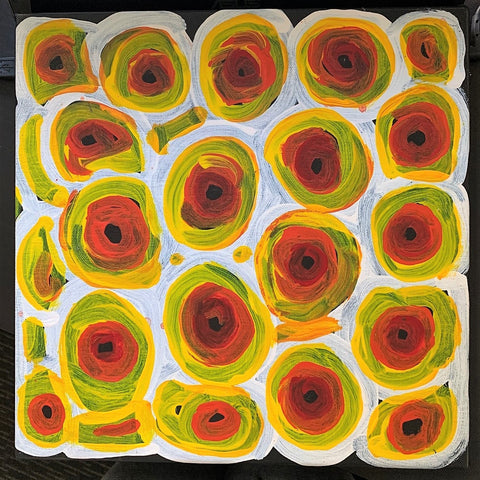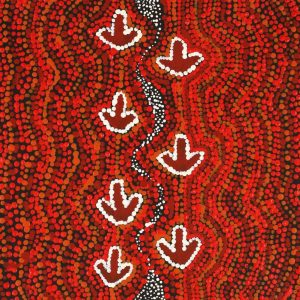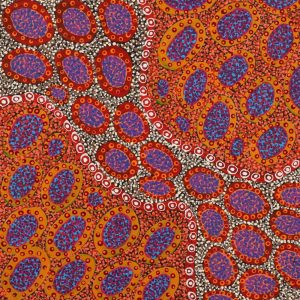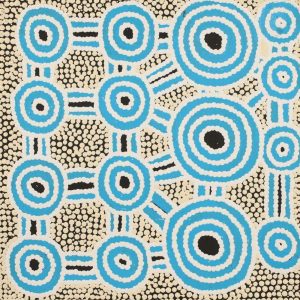Sarah Napurrurla Leo - Ngapa Jukurrpa (Water Dreaming) - 3601/23
Artist: Sarah Napurrurla Leo
Title: Ngapa Jukurrpa (Water Dreaming) - Puyurru
Cat No: 3601/23
Size: 30 x 30 cm
Acrylic on Canvas, Stretched with Certificate of Authenticity
Story:
The site depicted in this painting is Puyurru, west of Yuendumu. In the usually dry creek beds are ‘mulju’ (soakages), or naturally occurring wells. The ‘kirda’ (owners) for this site are Nangala/Nampijinpa women and Jangala/Jampijinpa men. Two Jangala men, rainmakers, sang the rain, unleashing a giant storm. The storm travelled across the country from the east to the west, initially travelling with a ‘pamapardu Jukurrpa’ (termite Dreaming) from Warntungurru to Warlura, a waterhole 8 miles east of Yuendumu. At Warlura, a gecko called Yumariyumari blew the storm on to Lapurrukurra and Wilpiri. Bolts of lightning shot out at Wirnpa (also called Mardinymardinypa) and at Kanaralji. At this point the Dreaming track also includes the ‘kurdukurdu mangkurdu Jukurrpa’ (children of the clouds Dreaming). The water Dreaming built hills at Ngamangama using baby clouds and also stuck long pointy clouds into the ground at Jukajuka, where they can still be seen today as rock formations.
The termite Dreaming eventually continued west to Nyirripi, a community approximately 160 km west of Yuendumu. The water Dreaming then travelled from the south over Mikanji, a watercourse with soakages northwest of Yuendumu. At Mikanji, the storm was picked up by a ‘kirrkarlanji’ (brown falcon [Falco berigora]) and taken farther north. At Puyurru, the falcon dug up a giant ‘warnayarra’ (rainbow serpent). The serpent carried water with it to create another large lake, Jillyiumpa, close to an outstation in this country. The ‘kirda’ (owners) of this story are Jangala men and Nangala women. After stopping at Puyurru, the water Dreaming travelled on through other locations including Yalyarilalku, Mikilyparnta, Katalpi, Lungkardajarra, Jirawarnpa, Kamira, Yurrunjuku, and Jikaya before moving on into Gurindji country to the north.
In contemporary Warlpiri paintings, traditional iconography is used to represent the ‘Jukurrpa’ (Dreaming). Short dashes are often used to represent ‘mangkurdu’ (cumulus & stratocumulus clouds), and longer, flowing lines represent ‘ngawarra’ (flood waters). Small circles are used to depict ‘mulju’ (soakages) and river bed.
Biography:
Sarah Napurrurla Leo was born in 1971 on Napperby Station, an area located 122 km north of Alice Springs in the Northern Territory of Australia. Sarah later moved with her parents from the Napperby homestead area to the Laramba Community, 205 km north-west of Alice Springs. The Laramba Community began in 1983 on the Napperby Station Homestead but moved to its present location in 1984. Sarah’s parents have both passed away. She has two sisters, Selma Napurrurla Leo and Katherine Napurrurla Leo and one brother Clement Japurrurla Leo. Her remaining Grandmother is Rita Nangala Dixon.
Sarah had a traditional upbringing, spending time with her parents who would take her out bush, around Napperby, showing her sites and teaching her the traditional ways of her country. Later she lived in Alice Springs where she met her husband who was from Yuendumu, an Aboriginal community located 190 km north-west of Alice Springs. Shortly after they were married they moved to Yuendumu where she has lived ever since. Sara found work with the Old People’s Program, and took care of the elderly, helping them when they were sick, being with them when they feel alone, or when they are frighten during storms.
Sarah has been painting with Warlukurlangu Artists Aboriginal Corporation, an Aboriginal owned and governed art centre located in Yuendumu, since 2008. She paints Karnta Jukurrpa (Womens Dreaming), her Grandmother’s Jukurrpa stories. These stories relate directly to her land, its features and the plants and animals that inhabit it. She also paints her Mother’s Jukurrpa, Ngurlu Jukurrpa (Native Seed Dreaming). Sarah uses an unrestricted palette to develop a modern interpretation of her traditional culture.
When Sarah is not painting she looks after her young son who was born in 2008.







